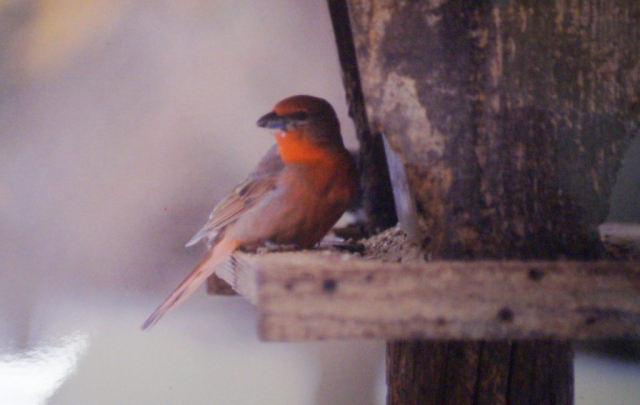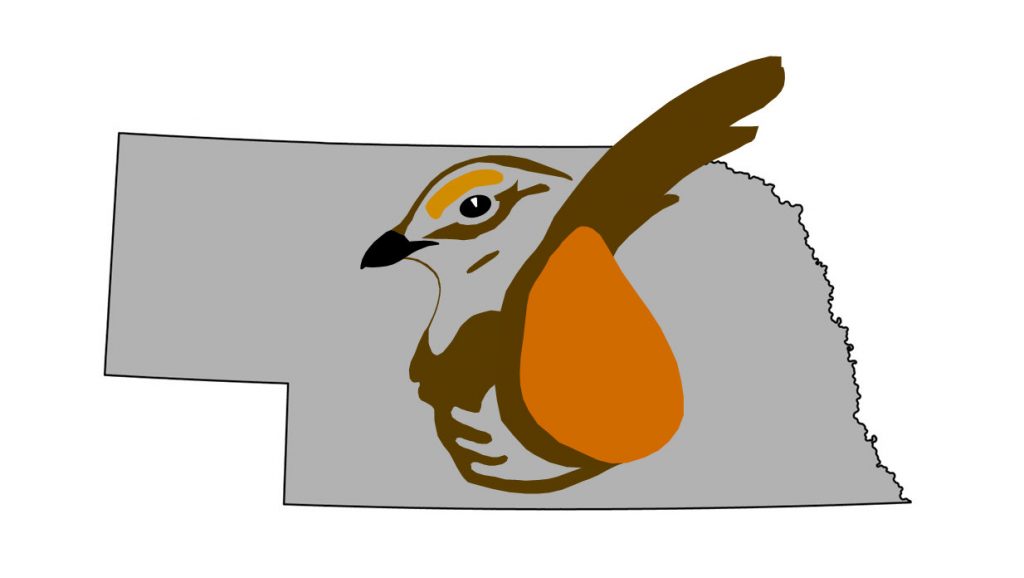Piranga flava
Status: Accidental in winter.
Documentation: Videotape: 6 Jan 1999 West Point, Cuming Co (Jorgensen 2001, 2003).
Taxonomy: Fifteen subspecies are recognized (Eddleman 2020, AviList 2025), usually divided into three groups, one northern consisting of five subspecies, two of which occur in the US: hepatica, breeding from northwest and central Arizona and southwest New Mexico south through highlands of Mexico, wintering from southeast Arizona and Sonora south, and dextra, breeding from the mountains east of the Continental Divide in north-central New Mexico through west Texas, and south to central Veracruz, eastern Oaxaca, and Chiapas, wintering south to Guatemala.
The subspecies of the Nebraska bird is unknown. Since it was a winter record, it apparently groups with the far-flung Oct-Jan records from Saskatchewan, Quebec, and Maine, and is not necessarily derived from the closest breeding population in Colorado (subspecies dextra). Such records are likely post-breeding dispersers.
Winter: There is one record:
18 Dec-6 Jan 1999 West Point, Cuming Co (Jorgensen 2001, 2003).
The single record is of a male at the feeders of Dr. and Mrs. David Mlnarik in West Point 18 Dec 1998-6 Jan 1999 that was photographed by Loren and Babs Padelford and videotaped including calls by Ross Silcock on 6 Jan (Jorgensen 2001, 2003). The bird apparently was taken by an accipiter, as a pile of red feathers was found 7 Jan (David Mlnarik, personal communication).
Comments: As recently as 1978 this species first appeared in Las Animas Co in southeast Colorado and began breeding there in 1980; it now breeds north to Pueblo Co and in Fremont Co (Eddleman 2020). Most of the numerous Colorado records are in the southeastern quarter of Colorado, although there are 11 on the plains north of the Arkansas River, all but one in May, the exception in Sep (eBird.org, accessed Jan 2024). There are three records for Wyoming, 22 May 1977 at Cheyenne, 7 Oct 1980 a female-plumaged bird at Casper, and fall 1980 at Cheyenne (Faulkner 2010). There are no records for Iowa or South Dakota, and three for southwestern Kansas 22 Apr-1 Jun (eBird.org, accessed Jan 2024).
The only other records northeast of the normal range for this species are of one in Illinois in Nov, two in Michigan Oct and Dec-Jan, one in Saskatchewan in Nov, one in Quebec in May, one in Ontario in May, and one in Maine Dec-Jan (eBird.org, accessed Jan 2024).
Thus, northeasterly reports near the breeding range are mainly of spring overshoot migrants while vagrants far from the breeding range occur mainly in late fall and winter.
A “red bird” in a large spruce in a yard in Scottsbluff, Scotts Bluff Co 13 Jun 1983 was thought to be of this species due to apparent dark mandibles, although the light conditions were judged to be inadequate to identify the bird (Cortelyou 1983). No other details were published, and its identity remains unknown.
Images
Abbreviations
AOS: American Ornithologists’ Society
Literature Cited
AviList Core Team, 2025. AviList: The Global Avian Checklist, v2025. https://doi.org/10.2173/avilist.v2025.
Cortelyou, R.G. 1983. 1983 (Fifty-eighth) Spring Occurrence Report. NBR 51: 66-78.
Eddleman, W.R. 2020. Hepatic Tanager (Piranga flava), version 1.0. In Birds of the World (A. F. Poole and F. B. Gill, Editors). Cornell Lab of Ornithology, Ithaca, NY, USA. https://doi.org/10.2173/bow.heptan.01.
Faulkner, D.W. 2010. Birds of Wyoming. Roberts and Company, Greenwood Village, Colorado, USA.
Jorgensen, J.G. 2001. 1999 (Eleventh) Report of the NOU Records Committee. NBR 69: 85-91.
Jorgensen, J.G. 2003. 2001 (13th) Report of the NOU Records Committee. NBR 71: 97-102.
Recommended Citation
Silcock, W.R., and J.G. Jorgensen. 2025. Hepatic Tanager (Piranga flava). In Birds of Nebraska — Online. www.BirdsofNebraska.org
Birds of Nebraska – Online
Updated 24 Jul 2025

